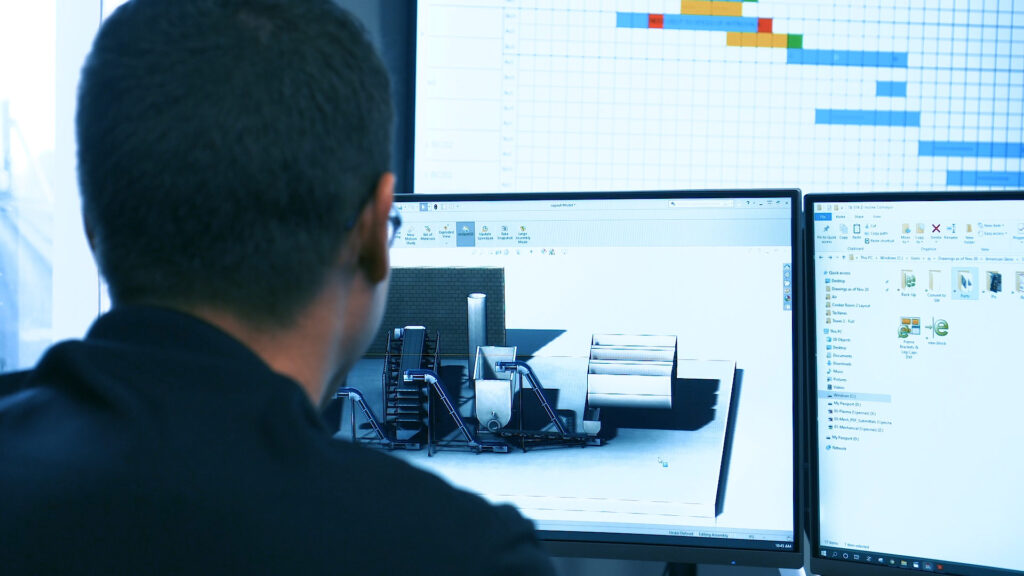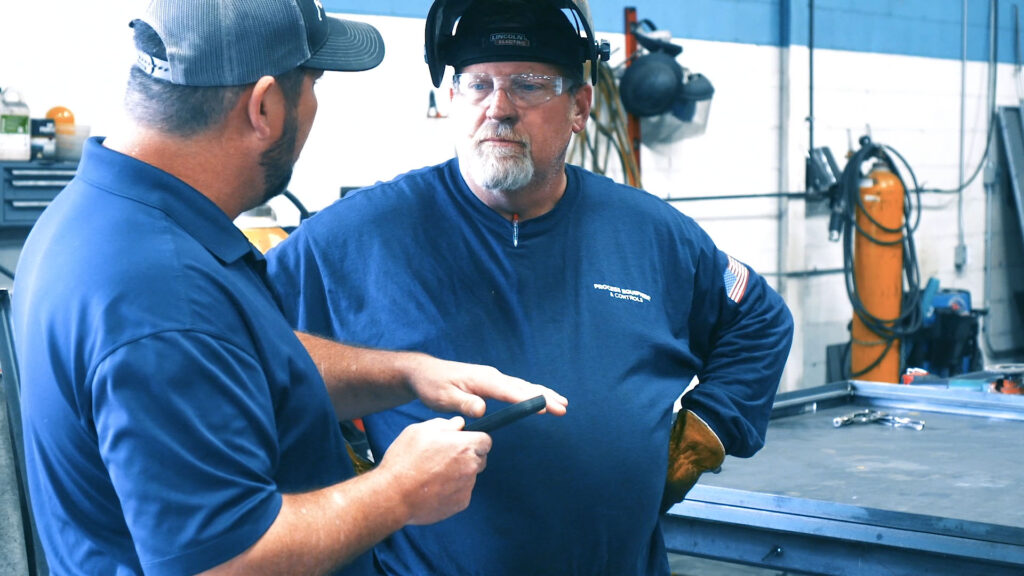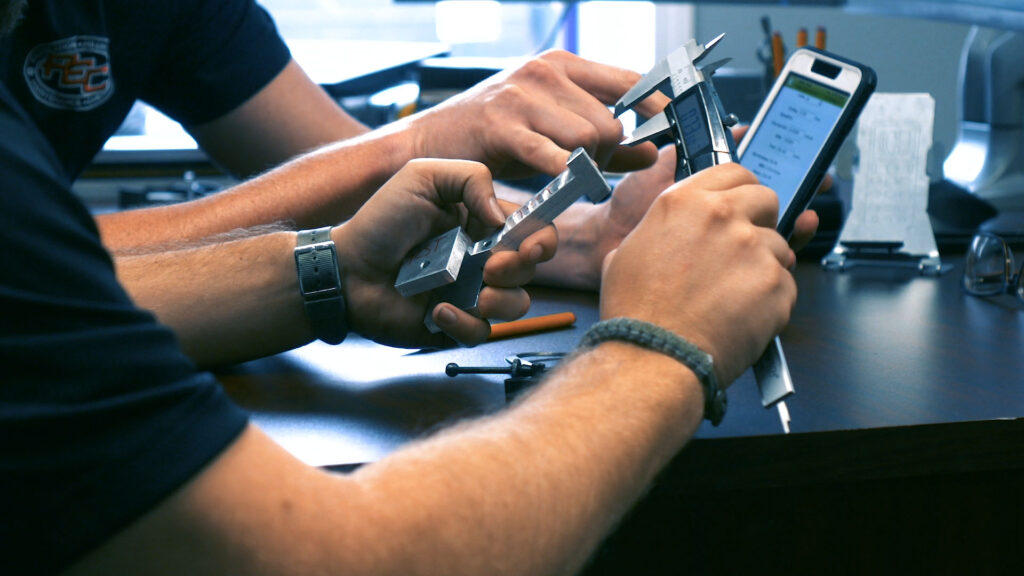
The engineering design process is how engineers solve problems in real-world settings. This structured approach helps teams stay on track and work toward a solution efficiently.
At PEC, we follow this process to improve systems, products, and performance. It’s not just about creating something new – it’s about solving a problem the right way.
The engineering design process is a way engineers solve problems. It’s like a cycle they can repeat if the first solution doesn’t work. This process helps engineers dig deep into the root of a problem to find a better and lasting solution.
Engineering teams from different fields use the design process to fix issues. Being able to go back to earlier steps is helpful when brainstorming new ideas for the future. The design process for engineers is like a think tank or brainstorming session for companies.
Whether it’s designing a new product, improving a system, or creating a more efficient process, the engineering design process provides a clear path to define the problem, collect data, and solve the problem effectively.
The design process is a series of steps that engineers follow, and these steps are usually the same across different projects. Below, we will explain these steps and what they might look like in real-world situations.
1
In this step, engineers define the problem they are trying to solve. They ask questions like:
For example, a company might need a machine that can package products faster to meet growing demand. Engineers need to understand exactly what the machine should do and what limitations they might have, such as budget or space.
This step is crucial because understanding the problem fully is the foundation for finding the right solution. It allows engineers to identify potential roadblocks and evaluate trade-offs.
2
Next, engineers collect data. They gather information about the problem and possible solutions. They might:
Collecting as much information as possible helps engineers make informed decisions in the next steps. Once they have gathered all the necessary information, they can move on to the design phase.
3
Now it’s time to brainstorm ideas. Engineers think creatively to come up with as many solutions as possible. During this brainstorming process:
While this might be the creative part of the process, it’s important to still have guidelines and timelines to make sure you’re on track to reach the goals.
4
The planning process takes the ideas and breaks them down. It combines these ideas with the goals from the “Ask” step and the possible methods from the “Imagine” phase.
Planning is where all the math and science behind the project come together to create a workable plan. This is when the engineering team starts to brainstorm and come up with ideas that will bring the project to life.
5
Engineers now put their plans into action by creating them. This can be:
This stage is crucial in the development process as it helps to save time and resources, ensuring that the final product meets all requirements and functions effectively.
6
Now it’s time to test the prototype. Engineers check to see if it works as expected. They might:
Testing is important because it lets engineers know whether their design will meet their clients’ needs. It also allows them to make any necessary changes before moving on to production.
7
Based on the test results, engineers look for ways to improve the design. They might:
Improvement can happen at any part of the design process, but it helps when the design has been tested to apply possible solutions.

For companies in Athens, GA, solving a problem quickly and correctly can make a big difference. Using the engineering design process ensures problems are solved step by step.
This structured method reduces mistakes and improves teamwork. It also helps keep projects on budget and on schedule.
The first step in solving a problem is to define the problem. Teams in Athens need to ask the right questions to understand what needs fixing.
This step sets the stage for all others. If the problem is unclear, the solution may not work.
Before building anything, engineers must collect data. This step includes research, expert advice, and reviewing past efforts.
Gathering data helps reduce risks and uncover better options. It also defines design requirements like time, materials, and budget.
Brainstorming encourages teams to explore potential solutions. In Georgia, our teams write down all ideas – even the wild ones.
A wide range of ideas leads to better results. This step is essential in the engineering process.

Once ideas are listed, teams must choose the best option. The idea chosen must meet design requirements and budget limits.
This step includes using math, science, and expert knowledge to pick the best plan. It’s how we move from thinking to building.
Prototypes testing is how ideas become real. Our team creates models, drawings, or digital designs.
Prototypes let us test and evaluate ideas early. This saves time and money in the long run.
Testing is the part of the engineering design process that shows if something really works. Engineers test performance, safety, and design quality.
Test and iterate as needed. If something fails, it’s not the end – it means we learn and improve.
Solving a problem often means testing more than once. Improvements come from what we learn during testing.
Georgia projects grow better through trial and error. The process focusing on constant improvement leads to success.

Using the design process saves the amount of time needed to fix issues. A clear plan keeps projects from getting off track.
This process includes repeat steps like testing and improving helps avoid guesswork. Teams work faster and smarter.
The scientific method helps build knowledge, while the engineering process uses that knowledge to solve real problems.
Both use steps including asking questions, testing ideas, and learning from results. Engineers use both to succeed.
Every good plan starts with clear goals. These goals are called design requirements.
Design requirements might include cost, materials, or space. Knowing these helps find the right answer faster.
No matter the size of the job, steps that engineers follow stay the same. From define the problem to improve, every step matters.
Whether it’s a factory upgrade or new equipment, using these steps keeps work smooth and results strong.

A working model is a key part of seeing if a solution will work. This might be a full-size prototype or a digital version.
Working models help with test and iterate steps. They’re vital to the process.
You can’t know if an idea is good without testing. Every potential solution goes through tests to prove it’s right.
Testing brings out flaws and strengths. It’s a major part of the engineering process.
Following a series of steps means nothing gets skipped. It also means issues can be caught early.
For Athens clients, this reduces delays and keeps projects moving smoothly. It’s how PEC delivers reliable outcomes.
At PEC, we follow a tested method that works. Our engineering process supports smart decisions and fast action.
Our team is trained in every step – from brainstorming to final design. We work with clients to solve challenges and meet goals.
At Process Equipment & Controls (PEC), we use the engineering design process to provide our clients with cost-effective solutions that deliver real, measurable improvements. Our approach allows us to streamline idea generation in a solution-driven environment.
Your business deserves a fast response to new projects or existing problems, and using the design process allows us to deliver that. Whether you need to improve a manufacturing process, design a new system, or solve complex engineering challenges, we are here to help.
Let’s talk about possible solutions for your design needs. Contact us today to find out how we can help your business succeed.
By embracing the engineering design process, you can ensure that your projects are well-planned, efficient, and successful. At PEC, we’re committed to helping you navigate each step, from defining the problem to creating and improving your solution. Let’s work together to turn your ideas into reality.